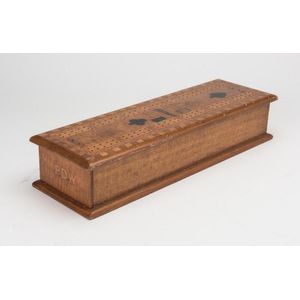French Inlaid Glove Box with Diamond-Studded Silk Interior
You must be a subscriber, and be logged in to view price and dealer details.
Subscribe Now to view actual auction price for this item
When you subscribe, you have the option of setting the currency in which to display prices to $Au, $US, $NZ or Stg.
- Ebony - Ebony is a close grained timber, black in colour. It has a fine texture which can be polished to a high gloss, making it suitable for venereering, inlay and stringing and its use as solid timber is resticted to small decorative items and ornamental decoration, such as chess pieces and musical instrument parts. The term "ebonised" means "faux ebony", timber that has been darkened during the polishing process to resemble ebony.
- Mother-Of-Pearl - Mother-of-pearl, technical name "nacre", is the inner layer of a sea shell. The iridescent colours and strength of this material were widely used in the nineteenth century as an inlay in jewellery, furniture, (especially papier mache furniture) and musical instruments.
In the early 1900s it was used to make pearl buttons. Mother-of-pearl is a soft material that is easily cut or engraved.
Nowadays it is a by-product of the oyster, freshwater pearl mussel and abalone industries. - Amboyna - Amboyna is a tree native to Indonesia (named after the Indonesian island of Ambon) and South East Asia, and when harvested the timber has a fragrant rose-like scent, and is of a rich brown colour, usually harvested from the burl of the tree with "birds-eye" markings . In furniture is is usually veneered and used for decorative effects on top quality pieces.
- Circa - A Latin term meaning 'about', often used in the antique trade to give an approximate date for the piece, usually considered to be five years on either side of the circa year. Thus, circa 1900 means the piece was made about 1900, probably between 1895 and 1905. The expression is sometimes abbreviated to c.1900.
This item has been included into following indexes:
Visually similar items

A Victorian mahogany writing slope, hinged lid with cut brass inlay and similar design to the keyhole escutcheon opening to reveal a lined and fitted interior with a secured drawer and recessed handle to the side. 50 cm x 29 cm x 20 cm

An Australian timber games box, silky oak, cedar, pine and blackwood, monogrammed 'P.D.W' on the drawer front, circa 1900. 8 cm high, 39 cm wide, 12.5 cm deep

Edwardian leather cigar box and cover in brown leather with tooled leather to lid, 18 x 4.5 x 8.6 cm

A mahogany writing box, English, circa 1865, 10 cm high, 36 cm wide 23 cm deep
